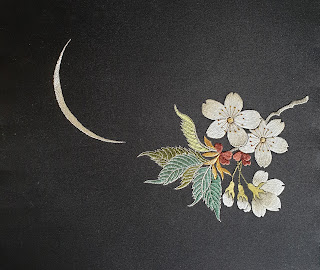Cherries and the Moon was the first piece I worked on after completing Queen of Flowers. It had not been on the frame quiet as long as Bridge BEW but I required a frame for another project and thought this piece would be the quickest to complete.
During the class with Kusano-senei, in June 2013, I had stitched a sample of each of the elements. Since then I had only stitched on Cherries and the Moon once more, when I completed the stitching on the moon.
© Shizuka Kusano/Carol-Anne Conway
In Japanese embroidery, we start with the elements furthest way from us, working from left to right, so the first area I worked on was the leaves (the frame is positioned length wise). These are relatively simple with a horizontal foundation and twisted silver outline and veins. I recalled that Kusano-sensei had encouraged me to exaggerate the tips of the serrations so that they would be obviously pointed.
© Shizuka Kusano/Carol-Anne Conway
Since 2013 I have become much more confident with long and short stitch and now, I can honestly say that I enjoy it. All of the cherry blossoms are stitched in long and short stitch. Sticking to the working order, I stitched the buds first.
Of the open blooms, only a single petal was stitched. When I looked at it, I thought that after so much time, I would not be able to match the stitching on that petal. I thought that it would be better to remove it and start again. Too late, I remembered that this was A Very Special Petal but what is done cannot be undone, or in this case, what is undone cannot be redone. Now it was up to me to restitch this petal beautifully in honour of what Kusano-sensei, Ishii-san, and Watakabe-san had taught me. I really enjoyed stitching these flowers. Kusano-sensei often uses shades of grey for white flowers; I think it gives them a certain grace and elegance.
© Shizuka Kusano/Carol-Anne Conway
Happy Stitching





















